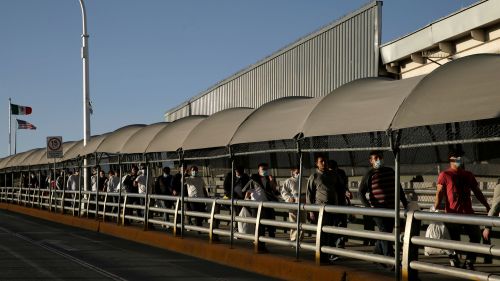When is a Crisis a "Crisis" and Why Does It Matter?

One of the defining features of 2020 has been the declaration of seemly one crisis after another, but why are some events declared crisis and why are others not?
One of the defining features of 2020 has been the declaration of seemly one crisis after another. As COVID-19 cases surge, most Americans are focused on the pandemic as the predominant crisis facing our country. However, the coronavirus is not the only crisis we face. The pandemic has catalyzed an economic crisis, with the head of the International Monetary Fund (IMF) warning that the strain on the world economy will lead us into “humanity’s darkest hour.” Notwithstanding the pandemic, Trump’s declared immigration crisis has created unfathomable insecurity for asylum-seekers. And as racism, police brutality, and police killings persist in the US, several cities and states have officially declared racism a public health crisis.
At the same time, there are countless other issues that could be called crises but are not. Take, for example, the rise and activities of white supremacists and domestic terrorism.
Why are some events declared crisis—whether by government institutions, the media, non-governmental organizations, individuals, etc.—and why are others not? Why should we—as citizens and consumers of media—care whether a crisis is declared or not?
We need to care because a declaration of crisis has the potential to force or encourage extreme action. We also need to care because the failure to declare a crisis can be an indicator of important injustices. And to care, I maintain that we have to understand how and why issues are constructed as crises, particularly the issue’s perceived level of threat to the security of the nation-state and the issue’s anticipated effect on privileged identities.
One reason a crisis is declared is when a nation-state perceives a legitimate threat to their country’s security. In the discipline of International Relations, the term securitization is used to describe how a nation-state will constitute a political issue as an extreme security threat, often by framing the issue with heightened language. An example of this is how the Trump administration deployed crisis language to justify an extreme stance on immigration policy in the United States. The White House cites the results of their “efforts to combat the crisis at our southern border.” This constructed crisis is the view that migrants from Central and South America are a threat to the security of American workers, taxpayers, and sovereignty—declaring this crisis has allowed the US government to justify the detention of 132,887 migrants last May, and the loss of at least 170 migrant children. In other words, the racist abuse and neglect of immigrant detainees are shielded under the guise of ‘security.’
Another explanation for why crises are declared depends on the identity of those whom the issue will most likely effect. If the challenges faced by certain groups are seen as legitimate by those in power, a crisis is more likely to be declared. For instance, reproductive rights activists have recently declared a “crisis in the courts” regarding how the Trump administration and Mitch McConnell’s remaking of the federal judiciary could “set back reproductive health rights for decades.” These ‘reproductive health rights’ are largely in reference to contraception and abortion access—historical concerns of the pro-choice movement that prioritizes the civil rights of white, straight, cis-women (a privileged population). However, the focus of the crisis for these rights-based advocates has consistently sidelined and whitewashed reproductive concerns for non-binary peoples, Indigenous women, Black women, and women of color.
How are the issues addressed by these reproductive justice advocates—such as the high mortality rates of Black women, the forced sterilization of Indigenous women, and the recent removal of health care protections for transgender folx—not also considered crises central to the movement for reproductive health? Intersectional movements that center on those directly impacted by reproductive injustices are silenced by the more palpable potential of rights-based movements favoring the reproductive health and freedom of white women.
So, sometimes crises are not declared even when large numbers of people think they ought to be. This matters because the failure to declare a crisis removes responsibility from those in power to act against said crisis. Consider the Trump administration refusing to declare the dangerous reality of white supremacy as a crisis, with Trump himself failing to condemn the violent white nationalist riot in Charlottesville circa 2018. By not declaring the threat of white supremacy and its associated violence as a crisis, the administration faces no obligation to address the issue. The preservation of whiteness and white supremacy’s hateful ideologies does not present a threat to the security of the prevailing systems of power in the United States. In fact, Trump arguably emboldens the rhetoric and activities of white supremacist groups and benefits from their continued support.
As citizens, we must care about the declaration of a crisis because of the action that follows. In the above examples, crisis language has allowed for the Trump administration to declare a threat to national security, and subsequently arrest, detain, and deport hundreds of thousands of migrants seeking asylum. Crisis language has also been deployed so that Planned Parenthood could launch a six-figure ad campaign to “spread awareness” about the threat to reproductive rights. These instances prove that crisis language has the potential to force or encourage extreme action in the form of policy enactment and the movement of funds.
Moreover, if we pay attention to which issues are being declared as crises and which are not, we can become aware of who is being excluded from the prevailing narratives on any given issue. For example, identifying where crises are declared within the reproductive health movement, we can understand the importance of advocating for intersectional work that focuses on the experiences of queer, trans, Black, Indigenous, and Latinx women. And in any case, we can aim not to accept the label of crisis at face value, but instead to interrogate how and why that word is being used.